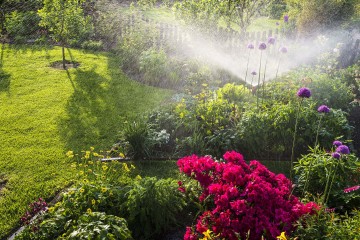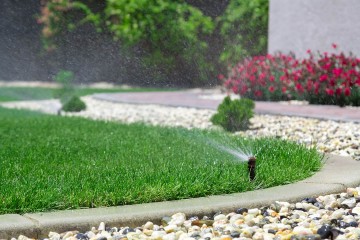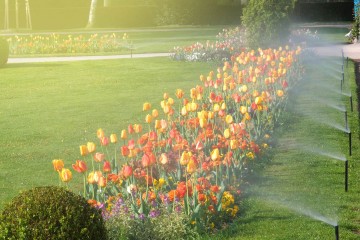Homeowners know the importance of an irrigation system to maintaining a lush lawn and thriving plants.
Irrigation systems also provide another advantage. They can control the amount of water put on a lawn and can be timed with accommodate water restrictions issued by many local governments in drought-prone areas. This also controls the amount of money you spend on water as well.
Picking out an irrigation system can be a bit daunting at first, but doesn’t have to be once you have some basic information. The main considerations should be water conservation, ease of use and cost.
There are three primary types of irrigation systems for residential use and include:
- Sprinkler systems
- Drip Systems
- Low-Water Systems
Sprinkler Systems
Sprinkler irrigation systems are the most common type of system used on residential lawns. They are permanently installed and provide advantages such as watering according to a timer and the ability to spray plants as well as water lawns. Since they are automatic, you will not need to remember watering restriction times because they can be set to accommodate that.
Sprinkler systems are the perfect choices for lawns and flower beds. They come in both high-tech and simpler options in a variety of price ranges. Some products in this category also include water conservation elements.
Installing them can be slightly burdensome because landscape contractors will need to dig trenches to place your sprinklers. This might briefly disturb your current lawn, but work shouldn’t take more than a few days.
Drip Irrigation Systems
This system is typically used for gardens and spaces with different types of trees, shrubs and perennials requiring ongoing watering. A drip system consists of flexible tubing and drippers. Drippers are placed near the root area of each plant.
The advantage of using this system is that you can control the exact amount of water going to each plant. It helps when you have a variety of plants requiring different amounts of water because each plant gets exactly what it needs. This is also an excellent way to conserve water. Drip systems are also wonderful at controlling weeds because it doesn’t water the ground between plants.
The cost of a drip system is more than a sprinkler system, but many homeowners find installing both at the same time saves money. Sprinkler systems cover the lawn and ground cover while the drip system is used for smaller spaces with specific plants.
Installation includes laying out landscape fabric after planting, then installing the tubes and drippers. Your landscaper will finish off the project with laying mulch to hide the tubes.
Low-Water Irrigation Systems
There are a number of low-water irrigation systems that work well. There isn’t one specific product that is better than another, but you should know what to look for to pick the right system.
- Look for systems that have consistent lower water pressure. This is best for your plants too.
- Look at precipitation rates. This refers to the amount of water coming from the head that covers a square foot of ground. The rate needs to be matched to the amount of ground the system is set to cover. You don’t want water meant for 200 square feet of ground to be dumped on a smaller area. Better yet, get a low precipitation rate nozzle.
- Get a system with an automatic timer.
Getting an irrigation system will save you time and help your plants. It is a solid investment for your landscaping that will be of use over decades.
If you’d like to know more about Irrigation Systems in Santa Cruz and Scotts Valley areas, please call K&D Landscaping at (831) 728-4018



